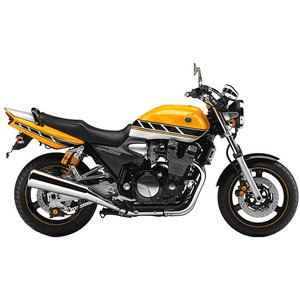Yamaha XJR 1300 [1998-1999]: A Timeless Muscle Bike for the Soulful Rider
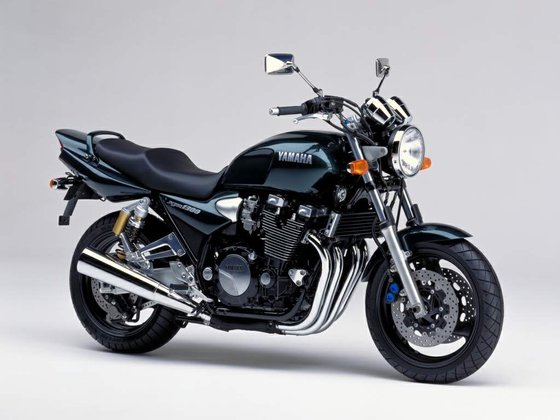
Introduction
The Yamaha XJR 1300 isn’t just a motorcycle—it’s a declaration. Built during an era when “naked bike” meant raw power wrapped in minimalist design, the XJR 1300 (and its limited SP variant) remains a benchmark for riders who crave authenticity. From its thunderous air-cooled engine to its unapologetically analog character, this bike is a love letter to motorcycling’s golden age. Having spent time with a meticulously maintained 1999 XJR 1300SP, I can confirm: this machine doesn’t just move you—it moves with you. Let’s dive into why this Yamaha still resonates decades later.
Design & Aesthetics
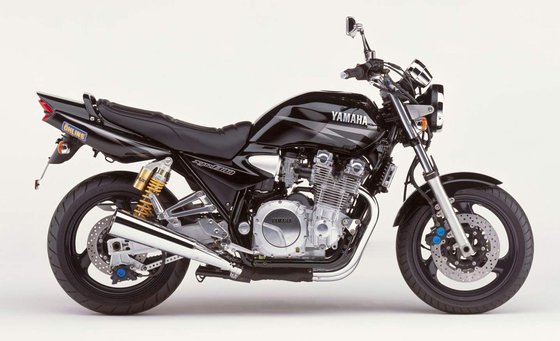
The XJR 1300’s design is a masterclass in muscular simplicity. Its steel double-cradle frame, exposed engine, and classic round headlight scream retro charm, but the devil’s in the details. The SP model adds flair with its Öhlins rear shocks (trademark yellow springs) and a two-tone paint scheme that subtly hints at its performance pedigree. At 2175 mm (85.6 in) long and 820 mm (32.2 in) seat height, it’s a substantial machine, yet the upright riding position feels natural. The analog gauges are refreshingly straightforward—no digital distractions here. This is a bike that looks as good parked outside a café as it does carving backroads.
Engine Performance: The Heart of a Lion
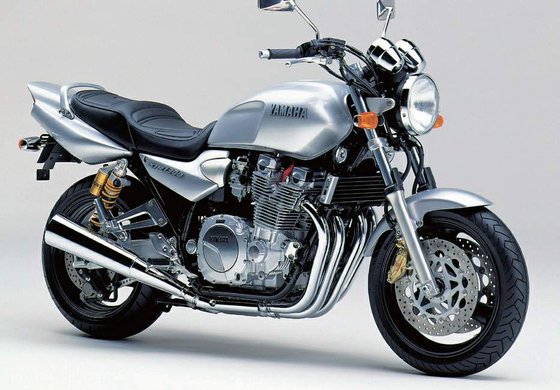
The 1251cc air-cooled inline-four is the star of the show. With 106 hp @ 8000 rpm and a stump-pulling 98 Nm (72.3 lb-ft) of torque @ 6500 rpm, this engine is all about accessible grunt. Thumb the starter, and the Mikuni carburetors wake up with a throaty growl that modern fuel-injected bikes can’t replicate.
Low-End Dominance:
Rolling on the throttle at 3000 rpm feels like uncorking a genie—the surge is immediate, linear, and addictively old-school. By 6500 rpm, you’re already at peak torque, making overtakes or highway pulls effortless. The 5-speed transmission is clunky by today’s standards, but that mechanical “clack” between gears adds to the charm.
Top-End Limitations:
Push past 8000 rpm, and the party winds down quickly. The engine’s air-cooled design and 9.7:1 compression ratio prioritize reliability over high-revving theatrics. Still, hitting its claimed 257.9 km/h (160.2 mph) top speed feels like a badge of honor—if your wrists can handle the windblast.
Fuel Efficiency:
At 15.1 km/l (35.5 mpg), the XJR isn’t frugal, but who cares? This isn’t a bike for spreadsheet riders. The 21-liter (5.5-gallon) tank ensures you’ll run out of stamina before it runs out of fuel.
Handling: A Study in Contradictions
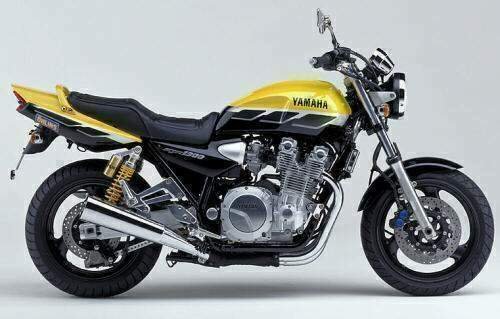
Weighing 240 kg (529 lbs) wet, the XJR 1300 isn’t a featherweight. Yet, its steel frame and 1500 mm (59 in) wheelbase lend surprising stability.
Straight-Line Confidence:
On sweeping highways, the XJR feels planted. The 43mm telescopic forks and Öhlins rear shocks (on the SP) absorb bumps without wallowing, though rough roads send judders through the bars.
Cornering Nuances:
Toss it into a corner, and the XJR rewards patience. The 25-degree rake and 100 mm (3.9 in) trail demand deliberate steering input, but once leaned over, the 120/70-ZR17 front and 180/55-ZR17 rear Michelins grip tenaciously. The SP’s upgraded suspension reduces squat under acceleration, but the front end still dives noticeably under hard braking.
Braking:
The R1-derived 298mm dual front discs with 4-piston calipers offer strong stopping power, though modern radial-mount setups outclass them in feel. The rear 245mm disc is adequate but forgettable.
Competition: How the XJR Stacks Up
The late ’90s naked bike wars pitted the XJR 1300 against legends. Here’s how it holds up:
- Suzuki Bandit 1200:
- Pros: Lighter, cheaper, and revvier.
- Cons: Flimsy chassis and budget suspension.
-
Verdict: The Bandit is a hooligan; the XJR is a refined brawler.
-
Kawasaki ZRX1100:
- Pros: Sharper handling and retro styling.
- Cons: Less torque, fussier ergonomics.
-
Verdict: The ZRX is a sportier cousin, but the XJR’s engine steals the show.
-
Honda CB1000:
- Pros: Smooth inline-four and build quality.
- Cons: Bland personality.
- Verdict: The Honda is competent; the Yamaha has soul.
The XJR 1300’s blend of torque, stability, and charisma still makes it a standout—especially for riders who value “feel” over outright agility.
Maintenance: Keeping the Legend Alive
Owning an XJR 1300 is a labor of love. Here’s what to watch:
1. Carburetor TLC:
The Mikuni BS36 carbs demand attention. Clean them annually, and consider a Dynojet kit ($269) for smoother response.
2. Valve Adjustments:
Check valve clearances every 26,000 km:
- Intake: 0.11–0.15 mm (0.0043–0.0059 in)
- Exhaust: 0.16–0.20 mm (0.0063–0.0079 in)
3. Oil & Fluids:
- Engine Oil: 3.3L of 10W-40 (API SE grade).
- Fork Oil: 538ml of SAE 10W per leg.
- Cooling: Air-cooled simplicity means no radiators—just keep fins clean!
4. Chain & Sprockets:
The 110-link chain and 17/38 sprocket combo wears quickly if neglected. Lubricate every 500 km.
5. Brake Upgrades:
Swap pads for sintered compounds and bleed with fresh DOT 4 fluid annually.
MOTOPARTS.store Recommendations:
- Exhaust: Over Racing’s stainless 4-into-1 system ($1,979) adds 10% power and a wicked snarl.
- Suspension: MX Tech’s 0.90kg/mm fork springs ($180) combat dive.
- Frame Brace: Over’s $849 alloy brace sharpens handling.
Conclusion
The Yamaha XJR 1300 isn’t perfect—it’s heavy, analog, and unashamedly old-school. But that’s precisely why it endures. This bike connects you to the road and the ritual of riding in a way modern machines often sanitize. Whether you’re chasing horizons or Sunday café runs, the XJR delivers a visceral experience that’s increasingly rare. For riders who cherish character over convenience, this Yamaha isn’t just a relic—it’s a revelation.
Upgrade your XJR 1300 with performance parts and accessories at MOTOPARTS.store—where legacy meets innovation.
Specifications sheet
| Engine | |
|---|---|
| Stroke: | Four-stroke |
| Ignition: | Digital TCI |
| Max power: | 77 kW | 103.0 hp |
| Max torque: | 98 Nm |
| Fuel system: | 4 x BS36 Mikuni carburetors |
| Lubrication: | Wet sump |
| Max power @: | 8000 rpm |
| Displacement: | 1251 ccm |
| Max torque @: | 6500 rpm |
| Configuration: | Inline |
| Cooling system: | Air-cooled |
| Compression ratio: | 9.7:1 |
| Number of cylinders: | 4 |
| Dimensions | |
|---|---|
| Wheelbase: | 1500 mm (59.0 in) |
| Dry weight: | 222 |
| Wet weight: | 240 |
| Seat height: | 820 mm (32.2 in) |
| Overall width: | 765 mm (30.1 in) |
| Overall height: | 1115 mm (43.9 in) |
| Overall length: | 2175 mm (85.6 in) |
| Ground clearance: | 132 mm (5.2 in) |
| Fuel tank capacity: | 21 L (5.5 US gal) |
| Drivetrain | |
|---|---|
| Final drive: | chain |
| Chain length: | 110 |
| Transmission: | 5-speed |
| Rear sprocket: | 38 |
| Front sprocket: | 17 |
| Maintenance | |
|---|---|
| Rear tire: | 180/55-z-17 |
| Engine oil: | 10W40 |
| Front tire: | 120/70-z-17 |
| Brake fluid: | DOT 4 |
| Spark plugs: | NGK DPR8EA-9 or NGK DPR8EIX-9 |
| Spark plug gap: | 0.9 |
| Forks oil capacity: | 1.1 |
| Engine oil capacity: | 3.3 |
| Engine oil change interval: | Every 5000 km or 2 years (recommended) |
| Valve clearance (intake, cold): | 0.11–0.15 mm |
| Valve clearance check interval: | 24,000 km (14,913 mi) |
| Valve clearance (exhaust, cold): | 0.16–0.20 mm |
| Recommended tire pressure (rear): | 2.5 bar (36 psi) solo, 2.9 bar (42 psi) with passenger |
| Recommended tire pressure (front): | 2.5 bar (36 psi) |
| Additional Notes | |
|---|---|
| Idle speed: | 1050 ± 50 rpm |
| Exhaust system: | 4-2-1 matt black |
| Standard tires: | Michelin Macadam radials |
| Chassis and Suspension | |
|---|---|
| Rake: | 25.0° |
| Frame: | Steel double cradle |
| Trail: | 100 mm (3.9 in) |
| Rear brakes: | Single 245 mm disc, 2-piston caliper |
| Front brakes: | 2 x 298 mm discs, 4-piston calipers |
| Rear suspension: | Swingarm with Öhlins coil spring/gas-oil damper |
| Front suspension: | Telescopic fork, coil spring, oil damped |
| Rear wheel travel: | 120 mm (4.7 in) |
| Front wheel travel: | 130 mm (5.1 in) |



